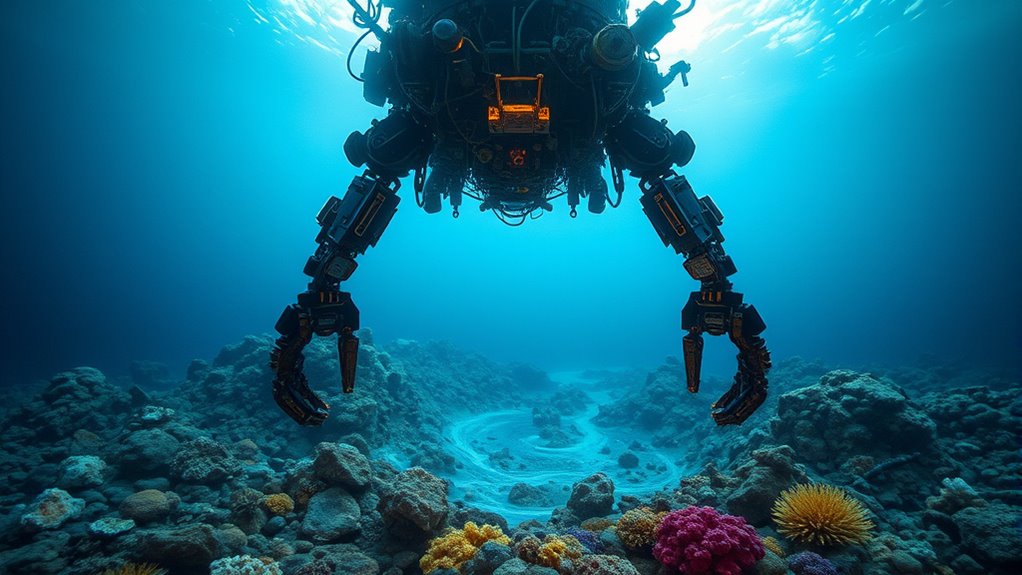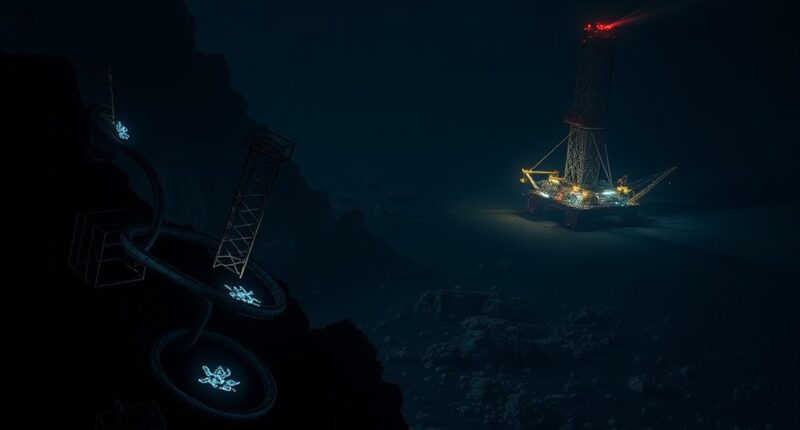Deep-sea mining offers vast mineral resources that can boost economies and support green technologies, but it also risks damaging fragile, largely unknown ecosystems. The disturbance from heavy machinery, sediment plumes, and noise pollution threatens deep-sea life with slow recovery times or irreversible harm. Balancing economic benefits with environmental protection is complex and requires cautious, responsible strategies. To understand how this balance plays out and what it means for our planet, keep exploring.
Key Takeaways
- Deep-sea mining offers access to valuable minerals essential for technology and green energy, boosting economic growth.
- Environmental risks include habitat destruction, sediment plumes, and harm to fragile, slow-growing deep-sea ecosystems.
- Many deep-sea species are poorly understood, risking irreversible ecological damage from mining activities.
- Responsible management and strict regulations are needed to balance economic benefits with environmental protection.
- The long-term environmental impacts may outweigh short-term economic gains, raising concerns over sustainability and conservation.

Have you ever wondered what lies beneath the ocean’s surface and how we extract valuable resources from its depths? Deep-sea mining promises access to vast quantities of minerals like cobalt, nickel, and rare earth elements essential for modern technology and renewable energy. But as you consider this potential, it’s essential to understand the environmental impact and the economic benefits involved. Deep-sea mining can offer significant economic advantages, creating jobs, stimulating local economies, and reducing reliance on land-based mining, which often has a heavy environmental footprint. By tapping into these resources underwater, countries and corporations hope to secure a competitive edge in the global market for metals critical to electronics, batteries, and green energy solutions. This promise of economic growth is compelling, especially for developing nations seeking new revenue streams. However, these benefits come with serious environmental concerns. The deep ocean is one of the least understood ecosystems on Earth, and mining activities could disrupt fragile habitats, destroy unique marine life, and cause long-term ecological damage. The process involves disturbing the seafloor using massive machines that scrape or vacuum up mineral-rich nodules, sulphide deposits, or crusts from the ocean floor. This disturbance can result in sediment plumes that suffocate marine organisms, while the noise and light pollution from mining operations can scare away or harm deep-sea creatures that rely on darkness and stability. Additionally, many species living in these depths are slow-growing and may take decades or centuries to recover, if at all, from such disturbances. The potential for unintended consequences makes many scientists and environmentalists wary of rushing into widespread deep-sea mining. They argue that the environmental costs could outweigh the economic gains, especially since the ocean’s ecosystems play a fundamental role in global climate regulation and biodiversity. Furthermore, once disturbed, the deep-sea environment may never fully recover, leading to irreversible losses of rare species and habitats. As you weigh the prospects, it’s clear that deep-sea mining is a complex issue balancing economic opportunities against the risk of environmental disaster. While it offers promising benefits, including resource security and economic development, the potential ecological costs prompt a cautious approach. Responsible management, strict regulations, and technological innovations are essential if we’re to harness these underwater riches without permanently damaging the ocean’s delicate balance. Ultimately, the decision to pursue deep-sea mining hinges on whether we prioritize short-term economic gains or the long-term health of our planet’s indispensable marine ecosystems.
Frequently Asked Questions
What Are the Potential Economic Benefits of Deep-Sea Mining?
You can benefit from the potential economic growth that deep-sea mining offers by accessing valuable minerals and resources. This industry promotes resource diversification, reducing reliance on terrestrial sources. It can create new jobs, boost local economies, and attract investments. While the risks are significant, the economic benefits might include increased revenue, technological advancements, and a stronger global supply chain, making it an appealing option for future development.
How Long Would It Take to Fully Develop Deep-Sea Mining Operations?
You might wonder how long it takes to fully develop deep-sea mining operations. It depends on overcoming technological challenges, which can take years of research and testing. Environmental impact assessments also add to the timeline, as regulations require careful planning. On average, it could take a decade or more before commercial-scale mining is fully operational, ensuring safety and minimizing environmental damage. Patience is key in this complex, evolving industry.
Are There Any Existing Deep-Sea Mining Projects Currently Active?
You’ll find that several active exploration and operational projects are underway in deep-sea mining. Companies like Nautilus and Ocean Infinity are actively exploring seabeds, aiming to develop commercial operations. While some projects are still in exploration phases, others have moved toward operational stages, though full-scale mining hasn’t yet begun. This ongoing activity highlights the growing interest and investment in deep-sea resources, with many eyes on potential environmental impacts.
What Are the Legal Regulations Governing Deep-Sea Mining Activities?
You should know that legal regulations governing deep-sea mining are primarily shaped by international treaties and regulatory frameworks. These agreements, like the UNCLOS, set standards for environmental protection and resource management. As you get involved or follow developments, it’s important to understand how these treaties guide activities, ensuring that mining operations comply with environmental and safety standards. Staying informed helps you grasp the legal landscape shaping this emerging industry.
How Can Environmental Damage From Deep-Sea Mining Be Mitigated?
Imagine the ocean as a fragile glass sphere, delicate yet essential. To prevent damage from deep-sea mining, you can use biodegradable coatings on equipment to reduce pollution and ease cleanup. Additionally, prioritizing habitat restoration after mining operations helps repair disrupted ecosystems. By adopting these strategies, you protect this precious sphere, ensuring the ocean’s health endures for future generations. Your actions make a tangible difference in safeguarding underwater life.
Conclusion
As you consider deep-sea mining, remember it’s a race to tap into a resource-rich area home to over 3 million undiscovered species. While it promises economic gains, studies warn that damage to fragile ecosystems could be irreversible. You have the power to stay informed and advocate for responsible practices. The question is, will you support exploring these depths responsibly or risk losing these essential habitats forever? The choice is in your hands.










